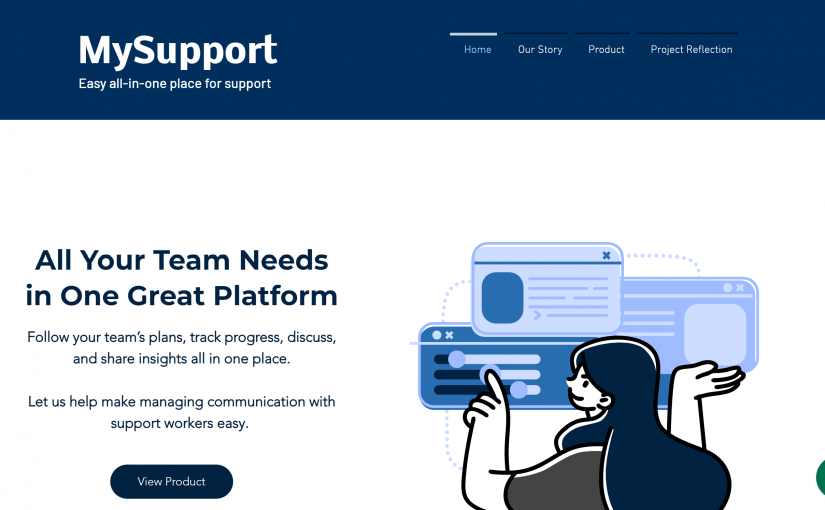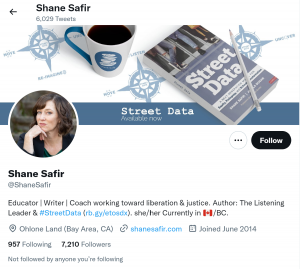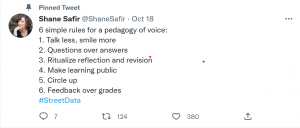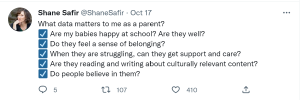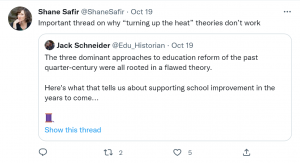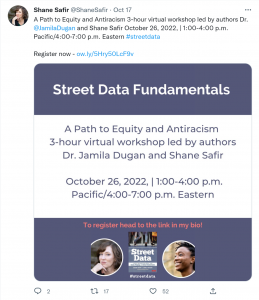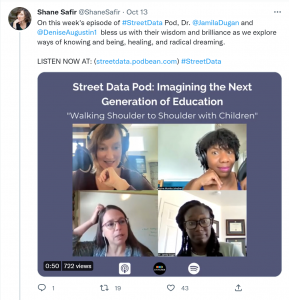Preface
This assignment was somewhat difficult and challenging to start, as it required one to look inwards at their own personal values and beliefs surrounding disability and dis/ableism, examining them critically through the theories and lenses of the course readings.
Borrowing the quote “the personal is political” from intersectional feminism theorists, theory and politics are not distant and abstract ideas, rather, they are intimately interconnected with the personal. With that in mind, I would like to reflect and examine the relationships and dynamics of my family and friends that are disabled or acquired a form of disability over the duration of our relationship.
The first relationship I would like to examine is with Ah-ma, my grandmother. I had a close relationship with her, as she took care of me growing up, I also watched her slowly age as time passed. It was undeniable that age-related conditions such as diabetes, high cholesterol, hearing loss and mobility issues emerged gradually and impacted her everyday living. I wanted to focus on my longitudinal observations of her mobility issues through the years in relation to her environment, and the ways environmental factors afforded or limited her agency and independence.
The second relationship I would like to examine is with my close friend A. He disclosed his disability early on in our friendship, which was something that I hadn’t encountered before. I wanted to reflect on the internal shifts and changes in both of our attitudes towards understanding disability in relation to the concept of a “temporarily abled body”.
Ah-ma – on Aging, Agency and Environmental Affordances
Ah-ma was one of my primary caretakers, living just a few allies away, my parents would drop me off at her house before going to work. Since we all lived in the same neighborhood, I spent a lot of time with her through my formative years, and one of my fondest memories include accompanying her grocery shopping at the traditional markets.
The traditional markets were a gathering place where Ah-ma would socialize and meet her friends, other grandmothers that also managed the household and took care of their grandchildren. As a young child, I remember the elderly ladies pushing strollers with their sleepy grandchildren, plastic grocery bags hanging from the handlebars, multipurposed as grocery carts. The older 5-story apartments in the neighborhood where Ah-ma lived had no elevators, which meant most of them had to carry stroller, groceries and grandchildren all up a narrow flight of stairs – Ah-ma did so too, barely breaking a sweat.
As a teenager, I continued to accompany her to the traditional markets. Ah-ma started walking with an umbrella that doubled as a walking stick, walking arm-in-arm pulling her grocery cart in tow. We still see her friends at the traditional markets; some of them carried walking sticks like Ah-ma; some had fancy grocery carts with small foldable seat for a quick rest, with triangular wheels so they could be easily pulled up the stairs. When her friends saw me, they would remark “how fast they grow!” their wrinkles looking a bit more defined as they smiled.
For university, I moved away from Taipei for my studies, but still visited home whenever I could during the summer and winter breaks. Having spent time away from Ah-ma, I forgot how unforgiving time can be sometimes, and she looked older than I had remembered. Her diabetes though manageable, impacted her mobility such that she started utilizing a cane for assistance.
I continued to accompany Ah-ma to the traditional markets. As her friends also aged through the years, many of them were seen accompanied with their live-in caretakers, as some family members seldom had time to provide care around the clock. Having forgotten who I was, her friends would comment “how young your live-in caretaker is!”, in which Ah-ma would reply “I don’t need a live-in caretaker yet, this is my granddaughter!”, perhaps as an attempt to assert her independence.
As we arrived at the apartment, I rushed to grab the groceries for her, not wanting her to strain or overexert herself too much. However, Ah-ma would insist on carrying it on her own. I watched her slowly make her way up the staircase, holding on to the handrails, making sure both feet were on the same step before taking the next one. She laughed and said that carrying the groceries is her “daily workout routine”, which caught me off guard – I had never considered it through that perspective! As I reflected more on her response, I realized…who was I to assume what was best for her, without consulting her experiential knowledge?
“An environment is perceived by the users according to their needs, at a specific time, they will assess how the environment will support or limit their behaviors or activities they want to accomplish” (Mahmood et al., 2020). On one hand, Ah-ma’s environmental affordances required her to maintain “active” by navigating up and down the staircases, walking to the traditional market a few blocks away to socialize with her friends at the park. On the other hand, the potential dangers of falling and injuring herself on the stairs, impatient motorcyclists zipping by as she crossed the street, the protruding banyan tree roots and uneven pavement at the park were of the family’s concern. How does one ensure the agency and independence of their elders while at the same time safeguarding them from potential dangers that come with the natural course of aging? How do we honor their self-sufficiency without patronizing their decisions?
At some point, my uncle decided to move her to a newer apartment, one that had elevators which he thought was more convenient and accessible for Ah-ma. However, the apartment was in a different area of the city, she was completely removed from her original social circle, isolating her from her familiar neighborhood and community.
“Functional decline over the years may impact how people experience their neighborhoods, along with changes in the community, such as alterations in infrastructure or relocation to different homes” (Mahmood et al., 2020). Now out of her element, she needed to readjust to her environment again. We noticed that she spent more time at home, since the nearest traditional market was not of walking distance, she relied on my uncle for assistance. Before, we would all check on Ah-ma as we lived a few allies away, however, it was much more difficult now that she lived further away.
“Place attachment may play even a more important role, such as supporting memory and connection with the past, providing a sense of belonging, relaxation, positive emotions and allowing activity, as well as promoting comfort and security” (Mahmood et al., 2020). Eventually, realizing that this change in environment was not sustainable for Ah-ma long-term, my family decided to move her back to her original apartment. Once again in her familiar circle, she resumed many of her previous routines, and seemed to feel more confident in her own self-sufficiency. I believe my family also felt more reassured in comparison to before, understanding that her independence was important to her.
A – Ambivalent Attitudes on Ableism and Able-bodied-ness
I became friends with A in Taipei when I flew home for the summer break in 2017. A was also in a similar situation, a Taiwanese student studying abroad visiting home over the break. We bonded over mutual interests and explored Taipei together, going to art exhibits and museums, indulging ourselves with street food at night markets, and bike rides along the riverside parks.
That summer, I learned how to skateboard, and was excited by how liberating it was to feel the world whizz by. A mentioned he used to skateboard, but not anymore, which piqued my curiosity. It was then that he disclosed to me about his prosthetic hip and chronic illness – he had injured his hip badly during a snowboard trip in high school, and complications from hemophilia during surgery resulted in needing a prosthetic hip replacement.
I remember his frankness while describing what happened, as if it weren’t his first time disclosing it. I also remember feeling rather inadequate and rude having brought up such a “taboo” topic of conversation without realization. Internally, I felt a strange sense of loss for him, perhaps out of pity, knowing that there are certain things that he enjoys but cannot do anymore, especially when we are still in our youth. Unsure how to proceed, I asked him how he felt about it, not wanting to outwardly place judgement so blatantly through an “oh, I’m sorry to hear that”.
This started a rather insightful conversation about how he manages his hemophilia on a day-to-day basis, his understanding of his physical limitations when it comes to his prosthetic hip, and his attitudes towards his disabilities in general. I found it interesting that he had differentiating attitudes towards disabilities and made a distinction between his hemophilia and prosthetic hip.
With “hidden disabilities” that are not outwardly apparent, I wouldn’t have known if A hadn’t told me about it, which, in retrospect, was a rather bold assumption for me to make. This made me reflect on the term of a “temporarily abled body” – a term to effectively bring people into one group and evoke a sense of empathy: some of us are disabled now and many of us can be sooner or later” as a reminder that the needs of some are really the needs of everyone (Edison and Notkin, 2010). It made a lot of sense to think of my flesh vessel as temporarily abled, while simultaneously confronting my own mortality in that existential sense, however, upon further research on disabled people’s opinions on this term, I realized it is not without its criticisms.
During his recovery from his hip surgery, A had a rather desolate outlook, stating “I would rather die than not be able to walk in the future or in my old age”, which somewhat shocked me – thinking back on it now, I wonder if his bitterness was coming from a place of self-pity or shame, or perhaps he had internalized this notion of ableism that is so imbued in our society? His attitude illustrated one major criticism of the term “temporarily abled body” that it calls upon a sense of “fearmongering”, implying that “disability, though not always deadly, is a fate worse than death” (Crippledscholar, 2015), which continues to perpetuate the negative stigma of having a disability to begin with.
Another criticism that I came across was the oversimplification of disabilities and its impact to a dichotomy that does not embody the nuances of “able-bodied-ness”, which also brings into question – “what is the definition of ‘able’, and ‘able’ to do what?”.
The “temporarily able body” focuses on the physical body, and excludes those that might have cognitive, mental or other ‘hidden’ disabilities that are “unapparent to outside observers and defies the outward social construction of disability” (Valeras, 2010). Disabled people can also be “temporarily able-bodied” when their “physical issue are not flaring up and leaves room for disabilities that tend to fluctuate in intensity over time”. Many others thought that the term “currently abled” portrayed a more inclusive and over-encompassing way of capturing different types of disabilities, and accounting for fluctuations in “ability” over time, in which attention, treatment and accommodation are still needed to manage and maintain themselves in a “mostly functional state” rather than an “impaired state”.
For this paper, I called A to ask him some questions about his internal feelings and beliefs towards himself and his conditions currently, curious whether it has changed after all these years?
With hemophilia being an inherited disorder affecting the clotting properties of blood, going to the pharmacy to pick up medication and administering injections on a weekly basis was “my normal everyday way of life from a young age”, he explained nonchalantly. With his current management and prevention, he didn’t think it impaired his functioning, and felt rather “normal”.
However, with A’s acquired hip injury resulting in a prosthetic implant, he expressed his initial deep sense of despair when he was “wheelchair-bound” during his surgery recovery, the gradual acceptance that he cannot do certain activities anymore, and the understanding of needing to “update” his prosthetic at some point in the future and going through the recovery process all over again. Until then, he mostly maintains his muscle mass and strength through working out and physiotherapy. He avoids activities that could possibly injure him, otherwise, he has moved away from the despair that he initially had and doesn’t feel like he identifies as a disabled person because it is currently well managed, “but who is to know what will happen in the future” he added on.
One thing that A still worries about is his insecurities of other’s doubt and suspicion viewing him as “different for no reason” as he “looks normal on the outside”, in which he kept his condition disclosed to only friends that he trusts. Echoing what the others mentioned, it sheds a different light on the idea of self-identification to the term “disabled”, and the ways A negotiated between when, where, how and why to disclose and adopt the disability identity, and when to “pass” as “able-bodied”.
Like with any term when we talk about disabilities, it is important that we think about the vast contextual and individual differences in nuance. People should care about disability rights, not out of fear that it could affect them personally someday, rather, people should care because they affect other human beings. We should center the voices and stories of those with lived experiences of disabilities and recognize that the way of self-identification is not as clear-cut as it seems, revealing the multiplicity and fluidity of identity overall.
Conclusion
In the beginning, I found some resistance and hesitancy to engage in such a reflective endeavor, in fear of what I would find in the deconstruction of myself and my past. I am grateful that through the interactions and conversations that I have with my family and friends, I am able to have a better understanding of their personal experiences, and therefore bringing more awareness and sensitivity towards this topic. At the same time, I am also grateful for this opportunity to introspect, as it is a necessary process to un-learn and un-pack my own implicit biases when it comes to thinking about disability, while maintaining an openness to re-learn new perspectives.
References
Crippledscholar. (2015, April 27th). Can We Please Stop Calling Able-Bodied People TABS. Crippledscholar. https://crippledscholar.com/2015/04/27/can-we-please-stop-calling-able-bodied-people-tabs/
Edison, L. T., Notkin, D. (2010, February 3rd). Guest Post: Temporarily Able-Bodied: Useful, but not always true. FWD/Forward. http://disabledfeminists.com/2010/02/03/guest-post-temporarily-able-bodied-useful-but-not-always-true/
Janz, H. & Stack, M. (2019). Interview with Dr. Heidi Janz: What is TAB? UBC.
Mahmood, A., O’Dea, E., Bigonnesse, C., Labbe, D., Mahal, T., Qureshi, M., & Mortenson, W. B. (2019). Stakeholders Walkability/Wheelability Audit in Neighbourhoods (SWAN): user-led audit and photographic documentation in Canada. Disability & Society, 35(6), 902-925. https://doi.org/10.1080/09687599.2019.1649127
Valeras, Aimee. (2010). “We don’t have a box”: Understanding Hidden Disability Identity Utilizing Narrative Research Methodology. Disability Studies Quarterly. 30. 10.18061/dsq.v30i3/4.1267.

